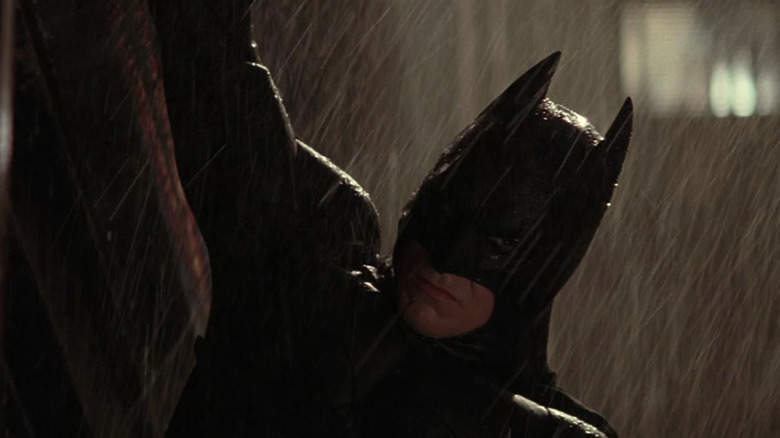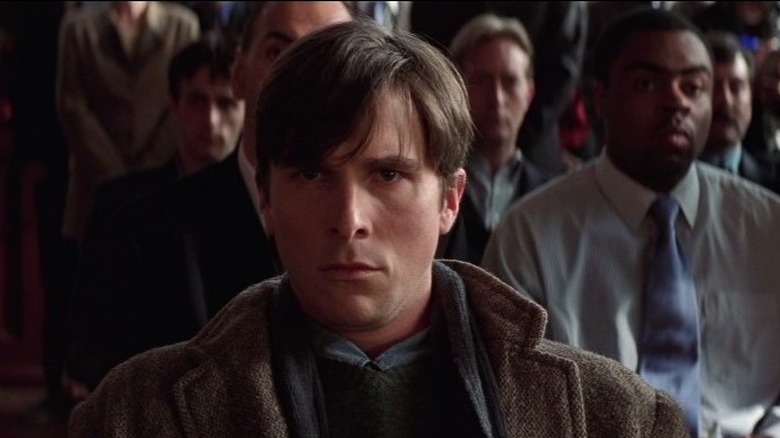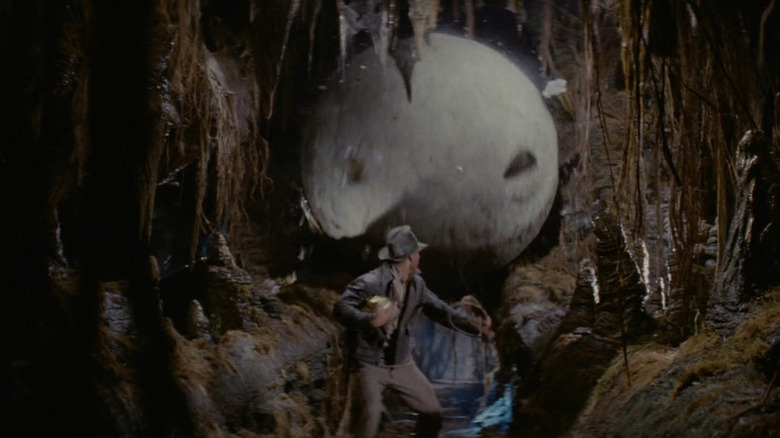Why Batman Shows Up So Late In Christopher Nolan's Batman Begins
We may receive a commission on purchases made from links.
"Batman Begins" is celebrating its 20th anniversary this year. The film was only a modest box office success during its original theatrical run, but it still redeemed Batman's image in critics and audiences' eyes after 1997's calamitous "Batman & Robin."
History has been kind to "Batman Begins," and it's definitely one of the most important comic book movies and Batman movies there has been. It was director Christopher Nolan's first blockbuster and action movie, an experience he'd refine on two more Batman movies, "Inception," etc. 2008's "The Dark Knight" is when Nolan became the Christopher Nolan, master filmmaker and box office record breaker, but "The Dark Knight" literally wouldn't have happened without "Batman Begins."
"Batman Begins" was not all Nolan, though. He co-wrote the screenplay with David S. Goyer, who got sole "Story By" credit on "Begins" and returned to co-write the later two "Dark Knight" films. (Goyer also wrote one of the segments in the animated anthology film "Batman: Gotham Knight," a "Dark Knight" prequel.)
While appearing on the "Happy Sad Confused" podcast, which is hosted by Josh Horowitz, to discuss "Batman Begins" turning 20 years old, Goyer revealed one concern Warner Bros. had about the movie.
As Horowitz noted, Bruce Wayne (Christian Bale) first appears in the Batman costume almost exactly an hour into "Batman Begins," which runs 140 minutes total counting the end credits. Horowitz speculated Warner Bros. was not happy about this, and Goyer confirmed that no, it was not. But this very fact is essential to "Batman Begins" and the film's characterization of its hero. Goyer explained why he and Nolan chose to hold off debuting Batman:
"We felt, no disrespect to the actors who had played Bruce Wayne prior to this, that as moviegoers, in a lot of these superhero movies, we were always just kind of twiddling our thumbs waiting for the character to get into the costume and for the movie to really begin. Why is that? I think because unconsciously, a lot of work was put into sort of realizing the hero but not the man or the woman behind the mask."
What makes "Batman Begins" sing is that it does do this work. You understand why Bruce chooses to put on his mask because, when he finally does become more than just a man, you've already spent so much time with him.
Batman Begins made Bruce Wayne into its main character
Compare "Batman Begins" to Tim Burton's 1989 "Batman" film. That one begins with Bruce (Michael Keaton) already being Batman. The first sequence of the movie is Batman ambushing two street criminals on a Gotham rooftop and leaving them with a warning: "I'm Batman."
The equivalent scene in "Begins" (which, again, happens at the hour mark) features Batman interrupting a drug shipment at Gotham harbor and capturing mob boss Carmine Falcone (Tom Wilkinson). He picks off Falcone's men one-by-one; the quick-cut sequence suggests a horror film with Batman as the slasher. Bale's Batman disappears into the shadows and then strikes, unlike Keaton's walking tank in a Batsuit. Batman only appears in full when he grabs Falcone from his car's sunroof and repeats Keaton's line: "I'm Batman." But when Bale says the line, it's not an introduction, it's a triumphant climax. Finally, our hero has become the man we knew he would.
Previous Batman films had depicted his parents' murders, aka why Bruce Wayne became Batman. But "Begins" was the first to show in detail how Bruce became Batman. There's a lot of space between "boy loses parents, makes vow to fight crime" and "well-trained vigilante with every gadget you can think of who dresses like a bat." (Nolan was inspired by the Batman comic "The Man Who Falls," which chronicles Bruce's entire life up to him becoming Batman.)
The Joel Schumacher Batman films tried to explore Bruce Wayne's character more, but it didn't work. In "Batman Forever," Bruce's (Val Kilmer) arc was supposed to be him coming to terms with his parents' deaths and choosing to be Batman, not out of guilt or obligation but as an affirmative destiny. Except, most of those scenes wound up deleted. "Batman & Robin," meanwhile, is too campy for any gravitas barring a brief exchange between Bruce (recast with George Clooney) and Alfred (Michael Gough) about Batman's purpose: "What is Batman if not ... an attempt to control death itself?"
Where "Batman Forever" fell, "Batman Begins" rose. The first scene is a young Bruce Wayne (Gus Lewis) falling into a bat cave. That fall inspires his fear of bats, a fear that eventually leads him to choose the image of a bat to frighten criminals. Then the movie cuts to a 25-ish Bruce in an East Asian prison right before he meets the man who will train him, Henri Ducard aka Ra's al Ghul (Liam Neeson).
The first act of "Batman Begins" continues cross-cutting like this, and it's an excellent structure; the film keeps up momentum yet can also dwell on its backstory. Instead of rushing to the Wayne murders, we see Bruce spending time with his father Thomas (Linus Roache), so when the inevitable comes, it's all the sadder. The flashbacks are all diegetically Bruce's memories, too, so they reinforce how his past is driving him as he trains to be Batman in the present.
How Indiana Jones inspired the action of Batman Begins
In his and Goyer's conversation, Horowitz compared "Batman Begins" to Richard Donner's 1978 "Superman: The Movie," which also takes its time getting to Superman in the costume. Goyer added he, Nolan, and co. mapped their structure compared to other comic book movies, like "Superman" and Sam Raimi's "Spider-Man," to show Batman's late arrival wasn't that late.
"We were ready to prosecute the case with [WB]," Goyer explained. He confirmed there was a draft that began with a cold open of Batman on the roof of Arkham Asylum spreading his cape as the police are pursuing him (which happens later in the movie), "but very quickly, thank God, we dispensed with that."
Reading between the lines of Goyer's words, you can glean what the root of Warner Bros.' worry was: No Batman in the first hour of the movie would mean there would be no action in the first hour. However, Goyer and Nolan were aware of that potential problem themselves. To ensure the audience didn't think Bruce Wayne was boring, they decided to show he could kick ass without a bat costume.
"We knew fairly early on that we needed to have the audience fall in love with Bruce Wayne," Goyer explained. "We needed to have [...] an amazing action sequence, as amazing as anything from 'Indiana Jones,' that involved Bruce Wayne and not Batman."
That action scene ended up being when Bruce escapes the burning League of Shadows fortress. Even before then, though, there are bursts of action, like when Bruce fences with Ducard over a frozen lake. This ensured the audience didn't subconsciously make the connection of "Bruce Wayne scenes = boring talky scenes, where's Batman?"
1987's "Batman: Year One" by Frank Miller and David Mazzucchelli (one of the major source materials for "Batman Begins") does something similar. The book has four chapters ("Batman" issues #404-407), but the first doesn't show Bruce in the batsuit. Instead, the first chapter follows him as he goes out fighting crime without a costume and fails because the criminals don't fear him. At the end of the chapter, he realizes he must "become a Bat," and he debuts as Batman in chapter 2. Like "Year One," "Batman Begins" understood that Bruce Wayne's origin can and should be an engaging, atmospheric, and action-packed story in its own right, not just table setting for Batman to debut.


